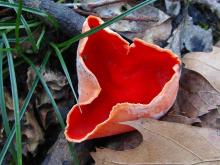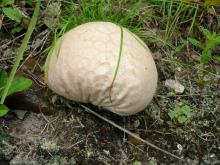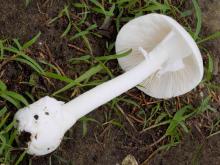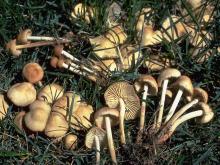Mushrooms
Media

Species Types
Scientific Name
Sarcoscypha occidentalis
Description
The stalked scarlet cup is, indeed, a tiny red cup on a tiny white stalk. It grows scattered on fallen wet sticks and branches in damp deciduous woods.
Media

Species Types
Scientific Name
Sarcoscypha dudleyi
Description
The scarlet cup is small, red, and usually stalkless, with a white outer surface. It grows on fallen wet sticks and branches in damp deciduous woods.
Media

Species Types
Scientific Name
Tremellodendron pallidum
Description
The jellied false coral is a branching, whitish, leathery, coral-like jelly fungus. It grows on the ground in deciduous or mixed woods.
Media

Species Types
Scientific Name
Calvatia gigantea (Langermannia gigantea)
Description
The giant puffball is a huge, white, smooth ball with a completely white interior that becomes yellowish green with age. It grows in open pastures, woods, and lawns.
Media

Species Types
Scientific Name
Amanita spp. (about 600 species, worldwide)
Description
This large group of mushrooms accounts for 90 percent of mushroom-related deaths, so every mushroom hunter should be familiar with amanitas. They contain one of the deadliest poisons found in nature!
Media

Species Types
Scientific Name
Laccaria laccata
Description
The common laccaria has a small, brownish pink cap with a central depression; the gills and stalk are a pale pinkish brown. Grows scattered or in groups in poor or sandy soil in mixed woods.
Media

Species Types
Scientific Name
Amanita bisporigera
Description
The destroying angel is all white, with a ring on the stalk and a large, saclike cup around the base of the stalk. This deadly poisonous mushroom is very common, growing on the ground in mixed woods and in grass near trees.
Media

Species Types
Scientific Name
Marasmius oreades
Description
The fairy ring mushroom has a tan to reddish brown, knobbed cap with off-white gills. It grows in grassy areas, lawns, meadows, often in circles called fairy rings.
Media

Species Types
Scientific Name
Pluteus atricapillus (formerly P. cervinus)
Description
The fawn mushroom has a brownish gray cap with whitish to pinkish gills and a whitish stalk. It grows singly or scattered, on dead wood or on the ground over buried wood.
Media

Species Types
Scientific Name
Gyromitra caroliniana
Description
The big red false morel belongs to a group of poisonous mushrooms. It has a reddish brown, convoluted, brainlike cap and a whitish stalk that is chambered inside. It grows singly or in groups in mixed woods.
See Also



Media

Species Types
Scientific Name
Monotropa hypopitys
Description
Pinesap is a plant that puts the "wild" in wildflower! It lacks chlorophyll, so its roots connect to fungi underground and absorb nutrients from the fungi.
Media

Species Types
Scientific Name
Cladophora, Pithophora, and Spirogyra spp., and others
Description
Filamentous green algae forms green, cottony masses that are free-floating or attached to rocks, debris, or other plants.
Media

Species Types
Scientific Name
Monotropa uniflora
Description
Indian pipe lacks chlorophyll, so it is white, not green. Below ground, its roots join with fungi that connect to tree roots. This plant, then, takes nourishment indirectly from the trees.
About Mushrooms in Missouri
Mushrooms are a lot like plants, but they lack chlorophyll and have to take nutrients from other materials. Mushrooms are neither plants nor animals. They are in a different kingdom — the fungi. Fungi include the familiar mushroom-forming species, plus the yeasts, molds, smuts, and rusts.
Always be cautious when eating edible mushrooms. Be absolutely sure of the ID, and only eat a small amount the first time you try it to avoid a reaction..





















